 W
WAbbesses is a station on Paris Métro Line 12, in the Montmartre district and the 18th arrondissement. Abbesses is the deepest station in the Paris Métro, at 36 metres (118 feet) below ground, and is located on the western side of the butte (hill) of Montmartre. Access to the platforms is occasionally by elevators, but they are typically accessed by decorated stairs.
 W
WThe Agoudas Hakehilos Synagogue, at 10 rue Pavée, in the 4th arrondissement of Paris, commonly referred to at the Pavée synagogue, rue Pavée synagogue, or Guimard synagogue, was designed by Art Nouveau architect Hector Guimard and erected between 1913 and 1914.
 W
WBouillon Julien, formerly Julien, is a brasserie-type restaurant in the 10th arrondissement of Paris, France. It was made an official Historical Monument for its Art Nouveau style.
 W
WThe Castel Béranger is a residential building with thirty-six apartments located at 14 rue de la Fontaine in the 16th arrondissement of Paris. It was designed by the architect Hector Guimard, and built between 1895 and 1898. It was the first residence in Paris built in the style known as Art Nouveau.
 W
WJules Aimé Lavirotte was a French architect who is best known for the Art Nouveau buildings he created in the 7th arrondissement in Paris. His buildings were known for his imaginative and exuberant decoration, and particularly for his use of sculpture and glazed ceramic tiles on the facades, made in collaboration with leading sculptors and the ceramic manufacturer Alexandre Bigot. He was three times awarded prizes by the city of Paris for the most original facades, for the Lavirotte Building at 29 Avenue Rapp (1901), for the Ceramic hotel, 34 Avenue de Wagram (1904), and for the building at 23 avenue de Messine in 1907.
 W
WThe Cimetière des Chiens et Autres Animaux Domestiques is often claimed to be the first zoological necropolis in the modern world. The ancient Ashkelon dog cemetery predates it by thousands of years. It opened in 1899 at 4 pont de Clichy on Île des Ravageurs in Asnières-sur-Seine, Île-de-France.
 W
WThe Galeries Lafayette is an upmarket French department store chain. Its flagship store is on Boulevard Haussmann in the 9th arrondissement of Paris but it now operates in a number of other locations in France and other countries. In 2009, Galeries Lafayette recorded earnings of over one billion euros. It is a part of the company Groupe Galeries Lafayette.
 W
WThe Galeries Lafayette is an upmarket French department store chain. Its flagship store is on Boulevard Haussmann in the 9th arrondissement of Paris but it now operates in a number of other locations in France and other countries. In 2009, Galeries Lafayette recorded earnings of over one billion euros. It is a part of the company Groupe Galeries Lafayette.
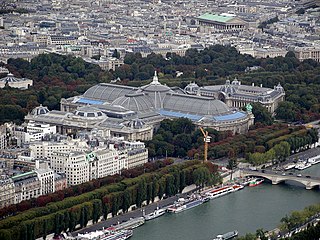 W
WThe Grand Palais des Champs-Élysées, commonly known as the Grand Palais, is a large historic site, exhibition hall and museum complex located at the Champs-Élysées in the 8th arrondissement of Paris, France. Construction of the Grand Palais began in 1897 following the demolition of the Palais de l'Industrie as part of the preparation works for the Universal Exposition of 1900, which also included the creation of the adjacent Petit Palais and Pont Alexandre III. It has been listed since 2000 as a monument historique by the French Ministry of Culture.
 W
WHôtel Guimard is an Art Nouveau town house built in 1909–1912 by Hector Guimard for use as his home and architectural studio, with a studio for his wife, the painter Adeline Oppenheim Guimard. It is considered one of the best surviving examples of his mature style. The house is located at 122 Avenue Mozart in the 16th arrondissement of Paris, France.
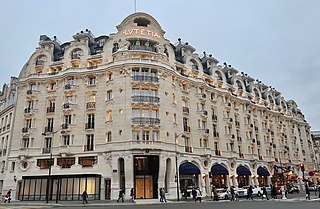 W
WThe Hôtel Lutetia, located at 45 Boulevard Raspail, in the Saint-Germain-des-Prés area of the 6th arrondissement of Paris, is one of the best-known hotels on the Left Bank. It is noted for its architecture and its historical role during the German occupation of France in World War II.
 W
WThe Jardin des Serres d'Auteuil is a botanical garden set within a major greenhouse complex located at the southern edge of the Bois de Boulogne in the 16th arrondissement, with entry at 1 avenue Gordon-Bennett, Paris, France.
 W
WThe Lavirotte Building, an apartment building at 29 Avenue Rapp in the 7th arrondissement of Paris, France, was designed by the architect Jules Lavirotte and built between 1899 and 1901. The building is one of the best-known surviving examples of Art Nouveau architecture in Paris. The facade is lavishly decorated with sculpture and ceramic tiles made by the ceramics manufacturer Alexandre Bigot. Lavirotte was awarded the prize for the most original new facade in the 7th arrondissement in 1901.
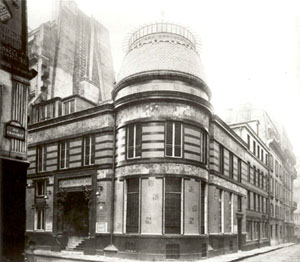 W
WThe Maison de l'Art Nouveau, abbreviated often as L'Art Nouveau, and known also as Maison Bing for the owner, was a gallery opened on 26 December 1895, by Siegfried Bing at 22 rue de Provence, Paris.
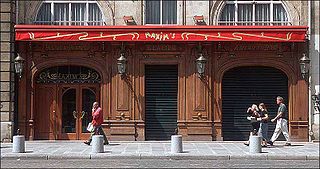 W
WMaxim's is a restaurant in Paris, France, located at No. 3 rue Royale in the 8th arrondissement. It is known for its Art Nouveau interior decor. In the mid 20th century Maxim's was regarded as the most famous restaurant in the world.
 W
WFrom the original plain white tilework and Art Nouveau entrances, the architecture of Paris Métro stations has evolved with successive waves of building and renovation.
 W
WBetween 1900 and 1913, Hector Guimard was responsible for the first generation of entrances to the underground stations of the Paris Métro. His Art Nouveau designs in cast iron and glass dating mostly to 1900, and the associated lettering that he also designed, created what became known as the Métro style and popularized Art Nouveau. However, arbiters of style were scandalized and the public was also less enamored of his more elaborate entrances. In 1904 his design for the Opéra station at Place de l'Opéra was rejected and his association with the Métro ended; many of his station entrances have been demolished, including all three of the pavilion type. Those that remain are now all protected historical monuments, one has been reconstituted, and some originals and replicas also survive outside France.
 W
WThe Pont Alexandre III is a deck arch bridge that spans the Seine in Paris. It connects the Champs-Élysées quarter with those of the Invalides and Eiffel Tower. The bridge is widely regarded as the most ornate, extravagant bridge in the city. It has been classified as a French monument historique since 1975.
 W
WPorte Dauphine is the western terminus of Line 2 of the Paris Métro. It is situated in the 16th arrondissement. Avenue Foch station, served by the RER C line, is located nearby, as is Paris Dauphine University.
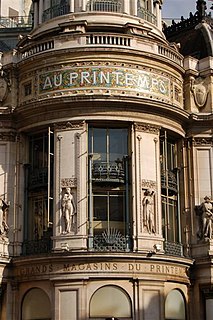 W
WPrintemps is a French department store chain. The Printemps stores focus on beauty, lifestyle, fashion, accessories, and men's wear.
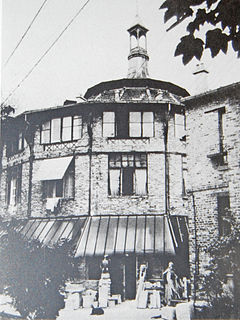 W
WLa Ruche was an artist's residence in the Montparnasse district of Paris. It now hosts around fifty artists and stages art exhibitions open to the public.
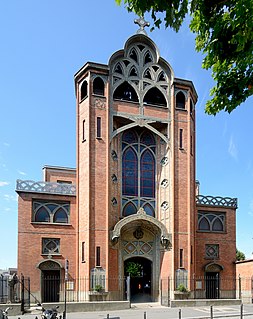 W
WSaint-Jean de Montmartre is a Roman Catholic parish church located at 19 Rue des Abbesses in the 18th arrondissement of Paris.
 W
WLa Samaritaine is a large department store in Paris, France, located in the first arrondissement. The nearest métro station is Pont-Neuf, directly in front at the quai du Louvre and the rue de la Monnaie. The company was owned by Ernest Cognacq and Marie-Louise Jaÿ who hired architect Frantz Jourdain to expand their original store. It started as a small apparel shop and expanded to what became a series of department store buildings with a total of 90 different departments. It is currently owned by LVMH, a luxury-goods maker. The store, which had been operating at a loss since the 1970s, was closed in 2005 purportedly because the building did not meet safety codes. Plans for redeveloping the building involved lengthy complications, as the representatives of the store's founders argued with new owners LVMH over the building's future as a department store or a mixed-use development. The revamped La Samaritaine is due to re-open its doors in February 2021 with retail offerings targeted at affluent consumers, restaurants, and a boutique hotel that includes a penthouse suite with its own private swimming pool. The building has been listed since 1990 as a monument historique by the French Ministry of Culture.
 W
WJules Aimé Lavirotte was a French architect who is best known for the Art Nouveau buildings he created in the 7th arrondissement in Paris. His buildings were known for his imaginative and exuberant decoration, and particularly for his use of sculpture and glazed ceramic tiles on the facades, made in collaboration with leading sculptors and the ceramic manufacturer Alexandre Bigot. He was three times awarded prizes by the city of Paris for the most original facades, for the Lavirotte Building at 29 Avenue Rapp (1901), for the Ceramic hotel, 34 Avenue de Wagram (1904), and for the building at 23 avenue de Messine in 1907.
 W
WThe Théâtre de l'Athénée is a theatre at 7 rue Boudreau, in the 9th arrondissement of Paris. Renovated in 1996 and classified a historical monument, the Athénée inherits an artistic tradition marked by the figure of Louis Jouvet who directed the theatre from 1934 to 1951. During the period when he was director, it became known as the Athenée Théâtre Louis-Jouvet.